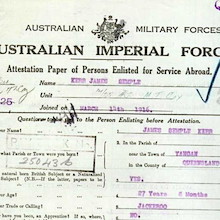
James Semple KERR
| Rank | Reg/Ser No | DOB | Enlisted | Discharge/Death | Board |
|---|---|---|---|---|---|
| Cpl | 5364 | 27y8m | 14 Mar 1916 | 9 Dec 1919 | 1 |
James Semple Kerr (1888-1979)
Family background and early life
James Semple Kerr was born at Yangan near Warwick in Queensland on 17 June 1888, the only child of James Kerr (1862 – 1889) and Christina née Tait (1863 – 1948). His parents and grandparents were closely associated with Saint Andrew’s Presbyterian Church. His grandfather, James Semple Kerr (senior) was the headmaster of the Normal School, an elder at Saint Andrew’s Church and one of the trustees when Saint Andrew’s was under construction in 1904. On his mother’s side, his grandparents were David and Christina Tait to whom the stained glass window, David and Jonathon was dedicated in 1923.
When James Semple Kerr was only one year old, his father James who was the teacher at the rural school at Yangan, died suddenly. Mrs Christina Tait moved back to Brisbane with her infant son and lived at her parents’ home named Luggie Bank at Tribune Street, South Brisbane. When he became old enough to earn a living, James Semple Kerr began as a warehouseman in Brisbane and later moved to the country and worked as a jackaroo.
Enlistment and service
On 14 March 1916 J. S. Kerr enlisted to serve in the AIF with reinforcements for the 25th Battalion training at Bell’s Paddock, Enoggera Camp. His unit embarked from Brisbane on board HMAT1 Itonus on 8 August. The troops disembarked at Plymouth and undertook further training in southern England till December. J. S. Kerr held the rank of provost corporal in the second half of 1916 but on transferring to the Australian depot in France in early 1917, he reverted to private.
The 25th Battalion was not involved in any major offensive role at this time. Private Kerr transferred to the 2nd Australian Ammunition Sub Park on 2 June 1917. In line with a move in 1918 to replace supply columns and sub parks with mechanical transport companies, he was appointed a motor transport driver in April 1918. In the same year, he was also granted two periods of leave in the United Kingdom.
After the armistice, Private Kerr was engaged in non-military employment at the Galeshiels Woolworks Technical College in Scotland before returning to Australia per HMAT Euripides in October 1919.
Return to civilian life in Australia
On his return from the war James Semple Kerr took up a selection at Hampden Downs, a property near Kynuna, a town on the Landsborough Highway between Winton and Cloncurry. He married the only daughter of Mr and Mrs W. H. Rudd of The Range, Rockhampton, Miss Iris Lorna Rudd, at St Paul’s Cathedral, Rockhampton on 7 June 1921. Mr Rudd was managing director of the Rockhampton firm, Walter Reid and Company.
Iris Lorna Kerr (1893 – 1961) became an industrial artist and product designer, an artist/photographer, craftworker and painter. Describing the years with her family on Hampden Downs prior to her successful career, her biographer wrote:
“Her life during the 1920s and 1930s was the common lot of most western women: home-making, rearing children, nursing them in sickness and death, surviving through drought and depression, and always offering visitors that hospitality for which the west was famous. Artistic activities were subsumed in making clothes and furnishings, but she continued to fill the ubiquitous autograph books with lively beings inspired by Norman Lindsay’s bears, Louis Wain’s cats, and Aboriginal corroboree groups in the manner of Tommy McRae.”2
Family and descendants
Their first child died in infancy but their family later consisted of two daughters and a son.
The son was Jim Kerr AM, born William James Semple Kerr (1932 – 2014), a pioneering heritage administrator, architectural historian and heritage practitioner. He influenced cultural heritage management practice in Australia over a long period. The Conservation Plan for Saint Andrew’s Uniting Church3 is based on the guidelines drafted by Jim Kerr in his famous work titled The Conservation Plan4 and the Burra Charter.5 It is noteworthy that Saint Andrew’s, constructed in 1904 under the watchful eye of a building committee of which James Semple Kerr (1836-1915) was an active member and now regarded as the finest example of neo-Romanesque architecture in the Southern Hemisphere, should now be protected by national principles devised and promoted by J. S. Kerr’s great grandson.
Passing
During the 1940s, James Semple Kerr and Iris moved to a property named Kunda in the Landsborough area. They later moved to Surfers Paradise then St Lucia. Iris Kerr died on 31 January 1961. For a short time James Kerr lived at Brookfield before occupying a unit at Hawken Drive St Lucia. Aged 90 years, he died on 24 March 1979. He was buried in a family grave at Toowong Cemetery.
Compiled by Noel E. Adsett, Brisbane, 25 June 2016 ©

SLQ Historypin – Linking our digital stories to the world.
The Lives, Links and Legacy Stories are being shared through the State Library of Queenland's QANZAC 100: Memories for a New Generation Historypin Hub. Visit this site:
Know anything about this person or want to contribute more information?
Please contact Miriam at staheritage@gmail.com







